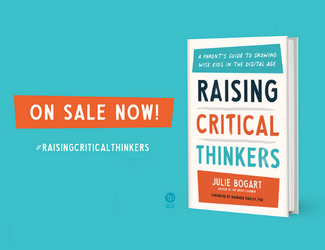You Have Time to Prepare

Do you remember how to divide fractions? I didn’t. I had a 4th grade math book whose page I turned and discovered, “Oops! We are up to division of fractions. I can’t remember how to do that.”
I whisked myself away to the garage to teach myself. My kids made messes in the living room.
I returned ready to show Noah how to divide fractions. He performed the task easily. At the end of the page, he commented, “So I don’t have to really remember this? I won’t need fractions as an adult? I only need to know them for today, right?”
Ha! He took a different lesson than the one I meant to impart. My inability to remember how to divide fractions stood out, naked and then ashamed. I countered that my handicaps in math were just that—skills I didn’t get to use when I needed them. I hoped for better for him, and I told him that I would do a better job of preparing to be his teacher in the future.
It’s with this experience in mind that I make the following recommendation. It is wise to prepare. In fact, it is essential to learn how to home educate your kids. It is entirely on task to read blogs, Facebook groups, books, and the directions that precede any lesson you expect your kids to complete.
In fact, it is so on task, may I make a bold statement? I know you don’t have time to study “learning” by yourself, in some ideal context of private, quiet, peaceful hours in the day. I know this.
Just Do It
My advice: just do it—right in the middle of the day with kids all around you, “off-task” in dress up clothes, acting out Frozen one more time. Tuck your feet under you, snuggle up to the corner of the sectional, and read, scroll, page. Use headphones if you need to. Highlighter in hand, read. Take notes. Absorb.
It is so much better to let go of today’s and tomorrow’s lessons in order to drill down to the essential ingredients of math or writing, or to understand a period in history, or to get a glimpse of how the science experiment should go and what its objective is, than to muddle forward with doubt and your child’s resistance.
 It is not better to just “get it done” and hope for the best. There is no “automatic” method for any learning. It just doesn’t happen that way. Depth, immersion, exploration, and guidance are the core values of education.
It is not better to just “get it done” and hope for the best. There is no “automatic” method for any learning. It just doesn’t happen that way. Depth, immersion, exploration, and guidance are the core values of education.
We are concerned with completion of pages or curricula, and then we worry that our kids aren’t making progress, and we hope for a quick fix—some solution that won’t require us to take valuable time to understand before implementation.
But this approach is backwards. You didn’t go to college (most of you) to get a teaching credential. You’re becoming educators on the fly (even unschoolers are embarking on a huge new project of how to be that parent who facilitates learning or invests deeply in a child’s passions). These choices necessitate information that informs how you spend time with your kids, and what you impart.
You will feel so much better if you have a handle on the contours of a subject area, than if you plod through a book hoping for magic (that the lesson leaps from the page without you knowing why or how it works).
You Have Time
For all the hours you don’t spend in preparation, you will find yourself frustrated with basic problems. Why isn’t my child of 10 spelling well? This is answered quickly in a book that explains the natural stages of growth in writing. 10 year olds don’t spell well. Here’s why, here’s how to foster the continued growth.
Without that bit of knowledge, you will be tempted to push your child or to shame him for not spelling well. I know. I’ve done all of that. I’ve pushed, I’ve shamed, I’ve blamed, I’ve plowed forward in a curriculum expecting it to teach and finding out it did not.
Then a new day dawned. I saw that my home life was fluid—we didn’t have set school hours, we didn’t have a teacher’s lounge for me. We had the mixed up mess of living and learning and all my insecurities about parenting and educating—together in one living room, at one kitchen table. It finally occurred to me: If I was unsure about how to impart a specific skill set for them or share about an area of passion for me, I could spend daytime looking into it. Right when I wanted to.
I wanted my kids to have an art education, but had no idea how to go about it. We spent time in the library where they read books they wanted, and I checked out books about art. I read them. I bought some. I started hanging prints on the wall. Finally, I ordered the 6 video set of Sister Wendy’s Story of Painting. I put them on every day for a couple of weeks, right after breakfast. My kids were free to come and go, but I took notes. They remember this period of our homeschool.
The foundation from that season was laid in me. I couldn’t wait to go to museums with the kids. They were excited to see paintings we’d already viewed in the video series.
I didn’t set out to make this a lesson for them. It was a lesson for me. I didn’t “go to another room” to understand it and then come back with the pretense of “Aha! Here’s the lesson you have to learn now.” Rather, I learned, in front of them.
Did our Sister Wendy odyssey take time away from math? Yes, yes it did.
It also showed me the value of taking time to prepare the feast of ideas I hoped would be my children’s education.
The benefits were life-changing:
- To understand—to be prepared.
- To get behind the lessons to why the lessons.
- To discover the germ of value in the material.
- To grow as an educator.
- To fuel my creativity.
- To spark my enthusiasm.
- To feel competent.
- To hold realistic expectations for each age and subject area.
These are the benefits of preparation. You deserve these benefits. Take the time to get them.
Top image by Pedro Ribeiro Simões (cc cropped)


















